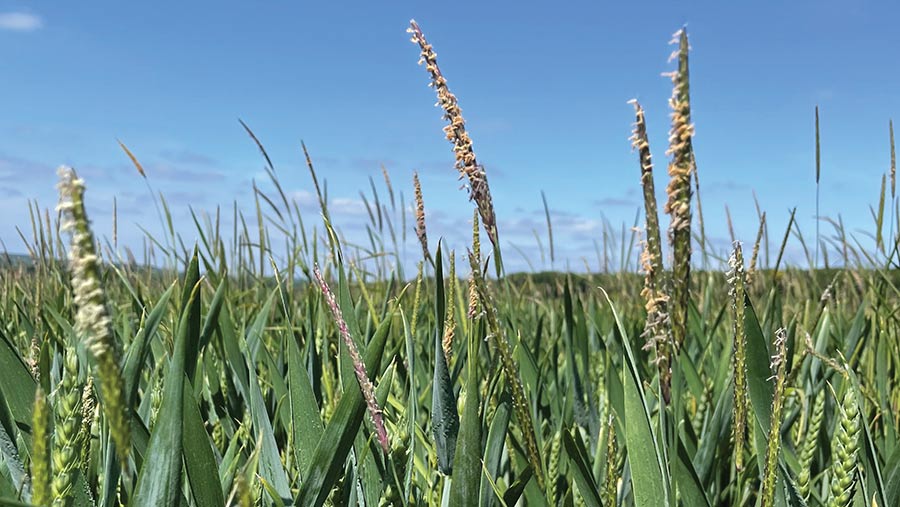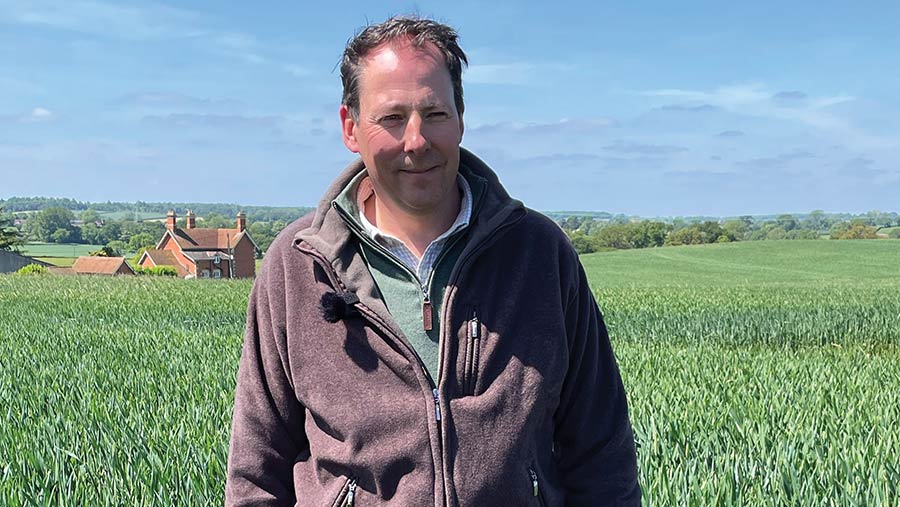Why blackgrass is so bad in 2023 and what to do about it
 © MAG/Richard Allison
© MAG/Richard Allison Some fields are unsuitable for winter cropping next season because of the surge in blackgrass seed return from the higher number of blackgrass heads in winter wheat crops.
And it may also be the year for farmers to hit the reset button, with ploughs being dragged out of the nettles to fully bury seed in badly infested areas.
This is according to Niab weed biologist John Cussans, who believes drastic action will be needed to get blackgrass back to manageable levels.
See also: Expert advice on using rotations to tackle blackgrass hotspots
As the post-mortem starts on a disappointing season, he says one notable observation was the very variable levels of success, sometimes seeing good and poor control on the same farm.
To understand why, he points to the extreme conditions last autumn and this spring.
The autumn
Last autumn, it came down to the conditions when the crop was drilled.
Looking at the experience at Niab’s Morley Farm in Norfolk, in the first half of October there was a prolonged period of low or no rainfall and limited sunshine.
It meant achieving a weed seed chit and effective stale seed-bed was difficult before drilling in many earlier sown crops.
Some crops were drilled at the start of this dry period and poor pre-emergence herbicide efficacy was seen.
“A lack of chit pre-drilling also meant more blackgrass plants were germinating into the sown crops,” John says.
When the rain did arrive in the second half of October, the higher soil moisture did mean high herbicide efficacy and relatively low weed plant numbers for many of the late drillers.
That’s why it is a very mixed picture in the autumn, he says.
The spring
Unseasonal conditions at the start of this year meant it was all about the development of the crop canopy, says John.
Relatively warm and dry conditions at the start of the year influenced crop canopy, resulting in reduced crop competition.
“You want canopies to take off and, with the later-drilled crops, the size of plants and surviving weeds meant they didn’t get much competition.”
Then around the optimum timing for spring graminicides, higher-than-normal rainfall saw fewer opportunities to spray.
This all means a very mixed picture in the spring.
So where next? He believes the focus needs to be on risk management.
“Because of the incredible variability in the level of fresh seed return between farms and fields, a real assessment of the risk (weed pressure/conditions) in following crops is needed.”
If no ploughing has been carried out in a field, maybe this is the year to think about a reset, he says, especially if bromes are also an issue.
Where is the weed pressure greatest? Then the farmer can tailor sowing date and herbicide programme according to risk.
In some cases, he believes some fields are simply not suitable for winter cropping.
Longer term
In the longer term, John believes farmers need to have more of a focus on the crop itself, especially the period of rapid growth in the spring.
“There is an increasing frequency of springs where crops are subject to stress when they should be making rapid growth and finish the work of the pre-emergence herbicides.”
Case study: Pasture Hill Farm, Lincolnshire

Lincolnshire farmer Daniel King © MAG/Richard Allison
A brand new herbicide has helped one Lincolnshire farmer buck the trend this year, with fields being the cleanest he has seen for some time.
And the only difference to his approach at Pasture Hill Farm near Bourne is the inclusion of Luximo (cinmethylin) in his pre-emergence herbicide stack.
Farm Facts
- 740ha of tenanted and contract farmed land in Lincolnshire
- Grows winter wheat, hybrid winter barley on cleaner land, winter beans and spring oats. Prefers oats as better than spring barley for smothering blackgrass and then into a first wheat.
Blackgrass has been Daniel King’s biggest weed problem on his heavy soils in south Lincolnshire in the past 20 years.
In response, he widened his rotation, incorporated spring crops, and now grows competitive, fast growing wheat varieties such as Cranium and Champion.
These are drilled at high seed rates of 550-600/sq m with the aim of having a minimum of 300-350 plants/sq m in spring.
Daniel also applies a robust herbicide programme and hand-rogues blackgrass, depending on labour availability.
Delayed drilling
But he says the single most successful technique for reducing blackgrass numbers is delayed drilling until mid-October.
“In the past 10-15 years, we have gone as far as we can with delayed drilling in the last few days of October,” he says.
“Drilling late is a nightmare on heavy soils like ours. We would love to drill earlier on our soils and the temptation is there, but the blackgrass will come back and bite you.”
Stale seed-beds are also part of his strategy. Where possible, a Horsch Terrano follows the combine to create a stale seed-bed. This is sprayed off at least once, if not twice, before drilling.
He has regained some control and believes he is getting up to 99% control, but admits it needs to be better to see further progress.
“It wasn’t getting worse, but we also didn’t seem to be improving.”
Luximo trials
Over the past three years, he has been involved in trials looking at BASF’s new herbicide Luximo, to see if this could help improve control by beefing up his herbicide success.
Trials proved successful and this season, all his wheat received Luximo.
His wheat was drilled last autumn with a 6m Horsch Sprinter on 25-31 October.
Within two days of drilling, his wheat received a pre-emergence stack of 500g/ha of Luxinum (cinmethylin), 50g/ha diflufenican, 1,000g/ha pendimethalin plus Avadex Factor (tri-allate).
Then on 12 November, the worst bits received 120g/ha of flufenacet. Ideally, Niab’s John Cussans says best practice would be to include another mode-of-action active, such as Defy (prosulfocarb).
Previously Daniel’s herbicide programme was Crystal (flufenacet + pendimethalin) plus diflufenican and Avadex (tri-allate).
Commenting on this year, he says: “Crops are cleaner than ever.”
BASF business development manager Stuart Kevis explains that in 56 trials over three years, they saw an average 12.5 percentage points improvement when using a mix of Luxinum and pendimethalin plus diflufenican, compared with a comparable mix of Liberator (diflufenican + flufenacet) plus aclonifen.
But is not just the average: it is also more consistent, while the alternative mix saw years where it underperformed and others where it matched the Luxinum mix.
In 29 out of 56 trials (52%), the Luxinum stack saw 90% or greater control. However, it was only 17 trials out of 56 where Liberator plus aclonifen gave 90% or greater control, he explains.
Looking at two years of trials under relatively high blackgrass pressure (average blackgrass head count of 187/sq m), results show that it is a step on from existing options, even outperforming some mixes.
Luxinum on its own gave 90% control while a mix of Crystal + diflufenican gave 82% control and Liberator plus aclonifen averaged 80% control.
This compares with flufenacet alone at 66% and straight aclonifen at 52%.
Based on this, BASF sees it as the best building block in a pre-emergence stack, and says it should be used within an integrated approach like the one adopted by Daniel.
Stale seed-beds
There is a belief that cultivating after the combine, getting a good blackgrass flush and spraying it off will always mean less will emerge in the following crop.
While that is true in wet conditions, work by Niab suggests it isn’t necessarily the case in very dry conditions.
That is because leaving seed exposed results in its degradation, while burying it just protects it.
So last year, the best approach in the bone-dry conditions was to do nothing until there was enough moisture to trigger germination.
Daniel King’s top tips for blackgrass control
- Delay drilling
- Grow competitive varieties
- Sow at robust seed rates

